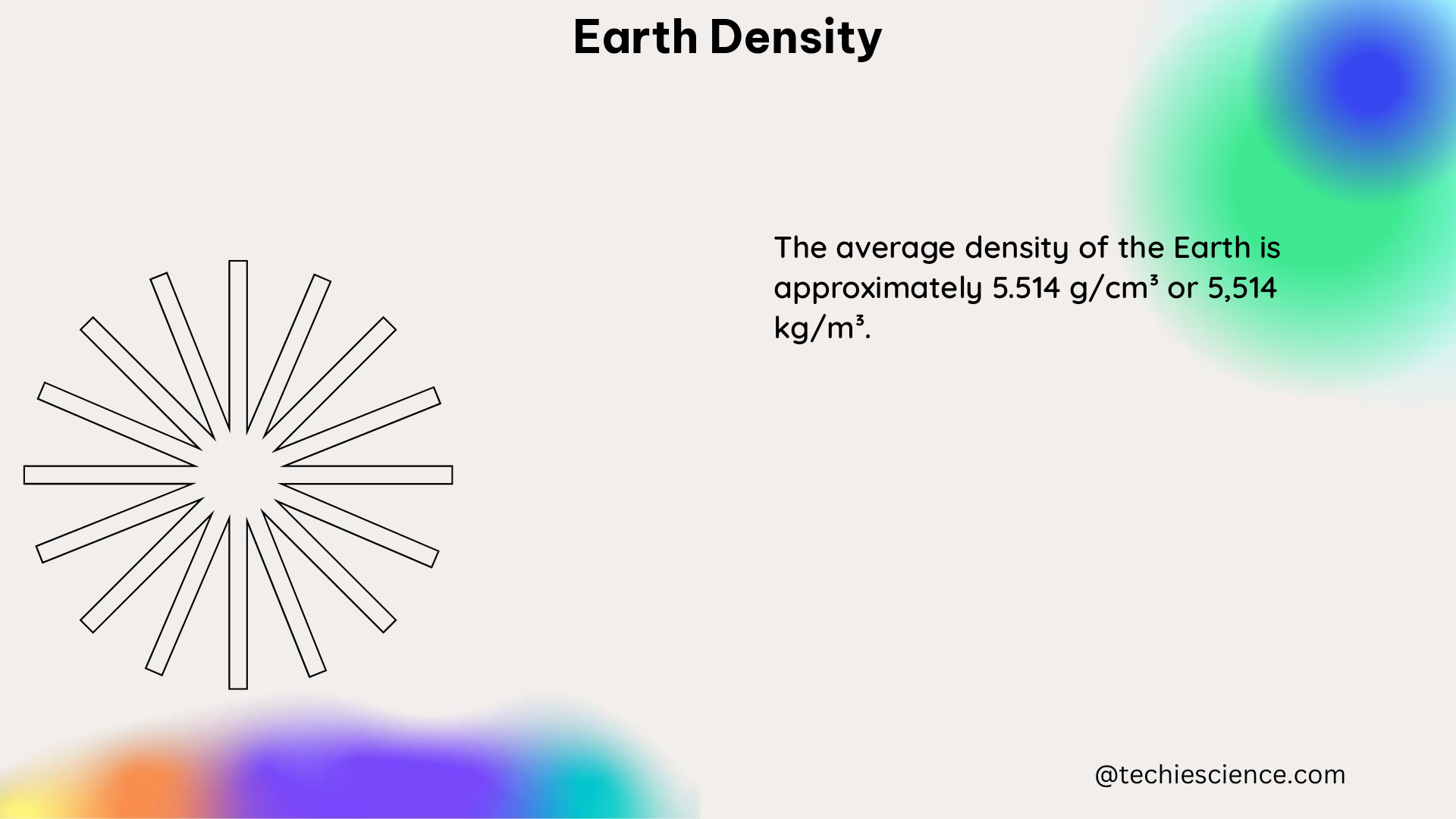The Earth’s density is a fundamental physical property that holds immense significance in various fields, including geophysics, geodesy, and planetary science. This comprehensive guide delves into the intricacies of Earth’s density, providing a wealth of technical details and practical applications to enhance your understanding of this crucial topic.
Understanding Earth’s Density
Earth’s density, also known as the average density of the Earth, is the ratio of the mass of the Earth to its volume. The accepted value for Earth’s density is approximately 5.515 g/cm^3, which is about 5.515 times denser than water.
Calculating Earth’s Density
The formula to calculate Earth’s density is:
Earth's Density = Earth's Mass / Earth's Volume
Where:
– Earth’s Mass = 5.972 × 10^24 kg
– Earth’s Volume = 1.083 × 10^12 km^3
Substituting these values, we get:
Earth's Density = (5.972 × 10^24 kg) / (1.083 × 10^12 km^3)
= 5.515 g/cm^3
Cavendish Experiment
In 1798, Henry Cavendish conducted an experiment to measure the density of the Earth. He obtained a series of measurements, which are presented in the form of the Earth’s weight relative to an equivalent volume of water. The data set includes the following values:
| Measurement | Value |
|---|---|
| 1 | 5.50 |
| 2 | 5.61 |
| 3 | 4.88 |
| 4 | 5.07 |
| 5 | 5.26 |
| 6 | 5.55 |
| 7 | 5.36 |
| 8 | 5.29 |
| 9 | 5.58 |
| 10 | 5.65 |
| 11 | 5.51 |
| 12 | 5.57 |
| 13 | 5.53 |
| 14 | 5.62 |
| 15 | 5.29 |
| 16 | 5.44 |
| 17 | 5.34 |
| 18 | 5.79 |
| 19 | 5.10 |
| 20 | 5.27 |
| 21 | 5.39 |
| 22 | 5.42 |
| 23 | 5.47 |
| 24 | 5.63 |
| 25 | 5.34 |
| 26 | 5.46 |
| 27 | 5.30 |
| 28 | 5.75 |
| 29 | 5.68 |
These values were used to create a stem-and-leaf plot, determine the five-number summary, and construct a boxplot to analyze the distribution of the data.
Specific Gravity of Earth
Earth’s density can also be expressed in terms of specific gravity, which is the ratio of the density of a substance to the density of water at a specific temperature and pressure. For Earth, the specific gravity is approximately 5.515, indicating that it is 5.515 times denser than water.
The formula for specific gravity is:
Specific Gravity = Density of Substance / Density of Water
Substituting the values, we get:
Specific Gravity of Earth = 5.515 g/cm^3 / 1 g/cm^3
= 5.515
Variations in Local Densities

In addition to the density of the Earth as a whole, local densities of rocks and minerals can vary significantly. This variation is influenced by factors such as the composition, structure, and formation processes of the materials.
Igneous Rocks
Igneous rocks, which are formed from volcanic eruptions, often have a low density due to the presence of air pockets. Some igneous rocks, such as pumice, can even float on water due to their low density.
Sedimentary Rocks
Sedimentary rocks, which are formed by the accumulation and consolidation of sediments, can have a wide range of densities depending on their composition and the degree of compaction.
Metamorphic Rocks
Metamorphic rocks, which are formed by the transformation of existing rocks under high temperature and pressure conditions, can also exhibit varying densities based on their mineral composition and the degree of metamorphism.
Applications of Earth’s Density
Understanding Earth’s density is crucial for a variety of applications, including geophysics, geodesy, and planetary science.
Geophysics
Earth’s density plays a key role in the interpretation of gravity data, which can be used to infer the subsurface structure and composition of the Earth. This information is essential for understanding the Earth’s internal structure, tectonic processes, and the distribution of natural resources.
Geodesy
Geodesy, the science of measuring and mapping the Earth’s surface, relies on the knowledge of Earth’s density to accurately determine the Earth’s shape, size, and gravitational field.
Planetary Science
The study of other planets and their properties, such as their mass and volume, also requires an understanding of Earth’s density as a reference point for comparison and analysis.
Conclusion
Earth’s density is a fundamental physical property that holds immense significance in various scientific disciplines. This comprehensive guide has explored the intricacies of Earth’s density, including the formula for calculation, the Cavendish experiment, specific gravity, and the variations in local densities. By understanding the technical details and practical applications of Earth’s density, you can deepen your knowledge and contribute to the advancement of geophysics, geodesy, and planetary science.
References
- CSUN, “HOMEWORK 3 Due: Feb.3 2024,” accessed on 2024-06-20, http://www.csun.edu/~an73773/Homework3S09ans.pdf
- SERC, “Density of Earth – Using Some Field Data – SERC – Carleton,” accessed on 2024-06-20, https://serc.carleton.edu/quantskills/activities/doe-field_data.html
- National Geographic Education, “Density,” accessed on 2024-06-20, https://education.nationalgeographic.org/resource/density/
- US EPA, “Gravity Methods | Environmental Geophysics | US EPA,” accessed on 2024-06-20, https://archive.epa.gov/esd/archive-geophysics/web/html/gravity_methods.html

The lambdageeks.com Core SME Team is a group of experienced subject matter experts from diverse scientific and technical fields including Physics, Chemistry, Technology,Electronics & Electrical Engineering, Automotive, Mechanical Engineering. Our team collaborates to create high-quality, well-researched articles on a wide range of science and technology topics for the lambdageeks.com website.
All Our Senior SME are having more than 7 Years of experience in the respective fields . They are either Working Industry Professionals or assocaited With different Universities. Refer Our Authors Page to get to know About our Core SMEs.